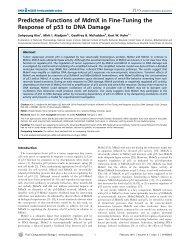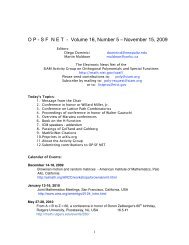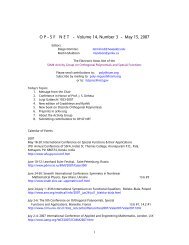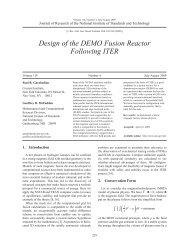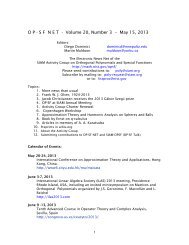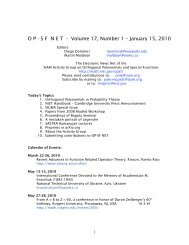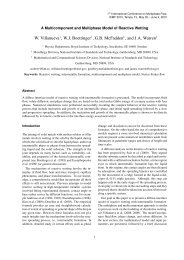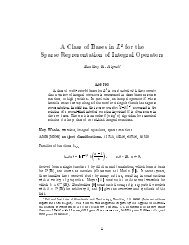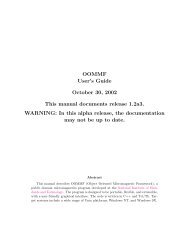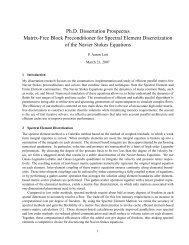Ranjan Roy
Ranjan Roy
Ranjan Roy
Create successful ePaper yourself
Turn your PDF publications into a flip-book with our unique Google optimized e-Paper software.
THE COTES-NEWTON FACTORIZATION OF x n ± 1<br />
RANJAN ROY<br />
The Cotes-Newton factorization formula is presented in the first chapter of the<br />
NIST Handbook. While Frank Olver and I were composing this chapter, I told him<br />
that I was researching the provenance and development of this and other key formulas,<br />
and he was helpful and encouraging. It was a real pleasure to work with Frank<br />
and I offer this bit of historical background in honor of his tremendous achievement<br />
in bringing the NIST Handbook to fruition in such accurate and accessible form.<br />
Newton was the first mathematician to investigate the factorization of the binomials<br />
xn ±1. It seems that his study of this very interesting problem arose in the course of<br />
his efforts to obtain series for π, similar to Leibniz’s famous 1673 series. Note that<br />
Leibniz’s series, contained in his letter for British mathematicians via Oldenburg,<br />
was first discovered by Madhava in the fourteenth century and may be written as<br />
π 1 1 1<br />
= 1 − + − + · · · .<br />
4 3 5 7<br />
In his October, 1676 reply to Leibniz via Oldenburg, Newton presented an interesting<br />
variation of the Madhava-Leibniz formula:<br />
π<br />
(1)<br />
2 √ 1 1 1 1 1<br />
= 1 + − − + + − · · · .<br />
2 3 5 7 9 11<br />
In this letter, Newton made a cryptic remark about how he derived the result, but<br />
evidence suggests that Leibniz did not understand his meaning. However, it is clear<br />
from Newton’s notes from around 1676 that he expanded (1 + x 2 )/(1 + x 4 ) as a<br />
series and integrated over (0, 1) to obtain the series in (1). He then factored x 4 + 1<br />
as<br />
(2) x 4 + 1 = (x 2 + √ 2x + 1)(x 2 − √ 2x + 1)<br />
and applied partial fractions to evaluate<br />
as a sum of two arctangents.<br />
1<br />
0<br />
1 + x2 dx<br />
1 + x4 In a 1702 paper, Leibniz factored<br />
x 4 + a 4 <br />
√−1 √−1<br />
= x + a x − a x + a − √ <br />
−1 x − a − √ <br />
−1<br />
and then wondered whether integrals such as<br />
<br />
<br />
dx/(x 4 + a 4 ) ,<br />
dx/(x 8 + a 8 ) , etc.<br />
could be evaluated in terms of logarithms and inverse trigonometric functions. This<br />
indicates that Leibniz had not deciphered Newton’s comment on how he evaluated<br />
1
2 RANJAN ROY<br />
(1).<br />
In his factorization of x n ±1, Newton used the method of undetermined coefficients;<br />
he learned this from his careful study of Descartes. In his old age, Newton described<br />
to de Moivre his method of reading Descartes: He followed the text until he came<br />
to a difficulty, and then began study from the beginning again; he found that by<br />
doing this, he could make progress beyond his stopping point, until he came to a<br />
new obstacle, sending him back to the beginning, and so on. Descartes discovered<br />
the technique of undetermined coefficients and used it to solve the quartic equation<br />
by first factorizing the quartic<br />
x 4 + px 2 + qx + r = (x 2 − yx + c)(x 2 + yx + d) ,<br />
and then equating coefficients to show that y 2 satisfied a cubic. In a similar manner,<br />
Newton started with the factorization<br />
(3) (1 + nx + x 2 )(1 − nx + px 2 − qx 3 + rx 4 − · · · ) = 1 ± x m ,<br />
when m = 3, 4, . . . , 12. By equating coefficients, he found the algebraic equation<br />
satisfied by n as he eliminated the other unknowns p, q, r, etc. For example, when<br />
m = 4 in (3), Newton had n 3 − 2n = 0, so that n = ± √ 2 when the coefficient of x 4<br />
was +1 and n = 0 when the coefficient was −1. For the case m = 8, Newton gave<br />
the equation for n as<br />
and he wrote down the solutions as<br />
n 7 − 6n 5 + 10n 3 − 4n = 0<br />
nn = 2 & 2 ± √ 2.<br />
The values n = ± √ 2 were involved in the factors of x8 − 1 and the values n =<br />
± 2 + √ 2 were in the factors of x8 <br />
+ 1. Newton also observed that 2 cos(π/8) =<br />
√<br />
1<br />
2 + 2 and drew a figure of a right triangle with an angle of 22<br />
2<br />
degrees. Thus,<br />
Newton would have required just one more step to obtain the Cotes factorization of<br />
x n ± 1. Another curious thing in Newton’s notes is that he wrote down the factors<br />
only when the coefficients of the factors could be expressed in terms of square roots.<br />
In his comments on Newton’s notes, Whiteside reflected on whether Newton had<br />
thought about the values of m in x m − 1, whose factors were expressible in terms<br />
of quadratic surds. This question is related to Gauss’s work on the constructibility<br />
of regular polygons. Of course, there is no suggestion that Newton made this connection.<br />
Now Newton did not publish any of this material and we may speculate that Cotes’s<br />
interest in this factorization problem was aroused by Leibniz and Johann Bernoulli’s<br />
1702 papers on the integration of rational functions. They had not succeeded in<br />
determining the factors of x n + a n , needed to evaluate dx/(x n + a n ). In a May<br />
5, 1716 letter to William Jones, Cotes wrote that he had resolved the factorization<br />
problem raised by Leibniz’s paper. Cotes died shortly after this, before publishing<br />
his work. His cousin, Robert Smith, edited Cotes’s unpublished manuscripts and<br />
had them printed as the Harmonia Mensurarum of 1722. Cotes had not given<br />
an explicit proof of the factorization formula; Henry Pemberton soon provided a<br />
geometric argument. We note that the Harmonia also presents without proof the
formula<br />
THE COTES-NEWTON FACTORIZATION OF x n ± 1 3<br />
(4) log(cos θ + i sin θ) = iθ .<br />
As described in the Harmonia, the formula contains an error in sign; the i = √ −1<br />
appears on the other side of the equation.<br />
In 1730, de Moivre published an analytic proof of a more general formula expressible<br />
in modern form as<br />
(5) x 2n − (2 cos nθ)a n x n + a 2n n−1 <br />
<br />
= x 2 <br />
2kπ + nθ<br />
− 2 cos<br />
ax + a<br />
n<br />
2<br />
<br />
.<br />
k=0<br />
This proof was based on a result de Moivre found in 1707: If l and x are cosines of<br />
arcs A and B of the unit circle and A : B = n : 1, then<br />
(6) x = 1<br />
<br />
n<br />
l +<br />
2<br />
l2 − 1 + 1 1<br />
√ .<br />
n 2 l + l2 − 1<br />
In modern form, this may be written as<br />
(7) cos θ = 1<br />
2<br />
<br />
(cos nθ + i sin nθ) 1/n + (cos nθ − i sin nθ) 1/n<br />
.<br />
De Moivre did not provide a verification of this result, but Daniel Bernoulli presented<br />
a proof in 1728. First, note de Moivre’s derivation of the product formula<br />
(5). He set<br />
z = n<br />
<br />
l + l2 − 1 or z 2n − 2lz n + 1 = 0 , where l = cos nθ .<br />
Then, by (6),<br />
x = (z + 1/z)/2 or z 2 − 2xz + 1 = 0, where x = cos θ .<br />
So de Moivre concluded that z 2n − 2lz n + 1 = 0, when z 2 − 2xz + 1 = 0; in other<br />
words, z 2 − 2xz + 1 was a factor of z 2n − 2lz n + 1. To obtain the other n − 1 factors,<br />
de Moivre gave a verbal argument, amounting to the formula<br />
(cos nθ ± i sin nθ) 1/n <br />
2kπ ± nθ 2kπ ± nθ<br />
= cos<br />
+ i sin<br />
, k = 0, 1, 2, . . . .<br />
n<br />
n<br />
This proved his factorization formula and he deduced Cotes’s formulas by taking<br />
θ = 0 and θ = π.<br />
In his 1728 paper on recurrent series, Daniel Bernoulli gave a result from which (6)<br />
can easily be derived. By a recurrent series, he meant a sequence A0, A1, A2, . . .<br />
such that<br />
(8) a0An+k + a1An+k−1 + · · · + akAn = 0, n = 0, 1, 2, . . . ,<br />
where a0, a1, . . . , ak were given constants. Bernoulli provided a method, usually<br />
presented in modern textbooks, for solving the difference equation (8). He also<br />
introduced the method of writing the general solution as a linear combination of k<br />
special solutions. We note in passing that it took a decade of struggle before Euler<br />
realized that the same idea could be carried over to linear differential equations<br />
with constant coefficients. As an application of his method, Bernoulli considered
4 RANJAN ROY<br />
the sequence sin θ, sin 2θ, sin 3θ, . . .. Note that the addition formula for the sine<br />
function implies that for An = sin nθ,<br />
(9) An+1 + An−1 = sin(n + 1)θ + sin(n − 1)θ = 2 cos θ sin nθ = 2 cos θAn .<br />
Taking Ax = λ x in (9) and dividing by λ n−1 produces<br />
The solutions of these equations are<br />
λ 2 − 2 cos θ λ + 1 = 0 .<br />
λ1 = cos θ + cos 2 θ − 1 = cos θ + √ −1 sin θ,<br />
λ2 = cos θ − cos 2 θ − 1 = cos θ − √ −1 sin θ ;<br />
note that λ1λ2 = 1. Using this and the initial values, one arrives at Bernoulli’s<br />
result<br />
(10) sin nθ = 1<br />
2 √ <br />
(cos θ +<br />
−1<br />
cos2 θ − 1) n − (cos θ + cos2 θ − 1) −n<br />
.<br />
Similarly, from the sequence 1, cos θ, cos 2θ, . . . , one may obtain<br />
(11) cos nθ = 1<br />
2<br />
<br />
(cos θ + cos 2 θ − 1) n + (cos θ + cos 2 θ − 1) −n<br />
.<br />
De Moivre’s (6) now follows immediately from (10) and (11). We remark that in<br />
1717 de Moivre had presented his discovery of the method of generating functions<br />
to solve the difference equation (8).<br />
Recall that Newton was interested in factorizing 1 + xm to evaluate integrals of the<br />
form xn dx/(1 + xm ) from which one could obtain various series for π. Of course,<br />
he was also interested in extending his table of integrals. Leibniz, Johann Bernoulli,<br />
and Cotes were also interested in the problem of integrating rational functions, but<br />
Euler was the first mathematician to write extensively on this subject. He devoted<br />
hundreds of pages to this topic, relating it to the gamma function, partial fractions<br />
expansions of trigonometric functions, and series for π and powers of π. In a 1744<br />
paper, he applied his work to the evaluation of the beta integral<br />
(12)<br />
∞<br />
0<br />
xm−1 dx<br />
, m < 2n .<br />
1 + x2n In a posthumous paper of 1785, he considered the more general integral<br />
∞<br />
x<br />
(13)<br />
m−1 dx<br />
1 − 2xk .<br />
cos θ + x2k 0<br />
Using de Moivre’s factorization (5), he expressed the integrand in partial fractions<br />
(14)<br />
xm−1 1 − 2xk k−1 <br />
=<br />
cos θ + x2k s=0<br />
where, with ωs = (2sπ + θ)/k,<br />
As + Bsx<br />
<br />
+ x2 ,<br />
1 − 2x cos 2sπ+θ<br />
k<br />
Bs = sin(mws − θ)<br />
, As = −<br />
k sin θ<br />
sin((m − 1)ws − θ)<br />
.<br />
k sin θ
THE COTES-NEWTON FACTORIZATION OF x n ± 1 5<br />
He noted that<br />
<br />
<br />
(As + Bsx) dx<br />
Bs(x − cos ωs)<br />
=<br />
1 − 2x cos ws + x2 1 − 2x cos ws + x 2 + (As + Bs cos ωs)<br />
1 − 2x cos ws + x 2<br />
= 1<br />
2 Bs log(1 − 2x cos ws + x 2 ) + As + Bs cos ωs<br />
arctan<br />
sin ws<br />
<br />
dx<br />
x sin ws<br />
(15)<br />
.<br />
1 − x cos ws<br />
Finally, Euler computed the value of the expression (15) at 0 and ∞ and summed<br />
it over s from 0 to k −1. The value at 0 may immediately be seen to be 0. However,<br />
the sum of the values at ∞ requires skill in dealing with trigonometric sums and<br />
Euler devoted several pages to this.<br />
The sums facing Euler were<br />
and<br />
k−1<br />
log x <br />
sin(2sα + ζ) , where α =<br />
k sin θ<br />
mπ<br />
k<br />
s=0<br />
and ζ =<br />
k−1<br />
1 <br />
(π − ws) cos(mws − θ) .<br />
k sin θ<br />
s=0<br />
(m − k)θ<br />
k<br />
His final result, obtained by clever use of the addition formula, was<br />
(16)<br />
∞<br />
xm−1 1 − 2xk m(π−θ)+kθ<br />
π sin k<br />
dx =<br />
cos θ + x2k k sin θ sin mπ .<br />
0<br />
Euler noted the special cases when θ = π/2 and θ = π:<br />
(17)<br />
∞<br />
x<br />
0<br />
m−1<br />
π<br />
dx =<br />
1 + x2k 2k sin mπ<br />
2k<br />
and ∞<br />
xm−1 dx<br />
(1 + xk m (1 − k =<br />
) 2 )π<br />
k sin mπ .<br />
0<br />
Of course, the second particular case can be directly obtained from the first. Euler<br />
deduced some remarkable partial fractions expansions from (16); for example:<br />
π sin(nη/k)<br />
2k2 sin η<br />
=<br />
sin(nπ/k) k2 − n<br />
k<br />
2 sin 2η<br />
− 2 4k2 3 sin 3η<br />
+<br />
− n2 9k2 4 sin 4η<br />
−<br />
− n2 16k2 + · · · .<br />
− n2 This series may also be viewed as the Fourier expansion of the function on the<br />
left-hand side.<br />
Dedekind’s 1852 doctoral thesis, written under Gauss’s supervision, succeeded in<br />
streamlining the evaluation of (17). Dedekind noted that his evaluation avoided<br />
the tedious computations at ∞ contained in textbooks. He started with the partial<br />
fractions expansion<br />
0<br />
xm−1 xn −1<br />
=<br />
+ 1 n<br />
n<br />
k=1<br />
ζ (2k−1)m<br />
,<br />
x − ζ2k−1 where ζ = eπi/n . Integration gave him<br />
(18)<br />
∞<br />
x m<br />
n −1 <br />
dx = n<br />
x + 1<br />
m−1 x<br />
xn n<br />
dx = − ζ<br />
+ 1 m(2k−1) log(ζ 2k−1 − x) .<br />
k=1<br />
k<br />
,
6 RANJAN ROY<br />
At x = 0, the sum without the negative sign would be<br />
n<br />
(19) ζ m(2k−1) log(ζ 2k−1 ) = πi<br />
n<br />
(2k − 1)ζ<br />
n<br />
m(2k−1) π<br />
=<br />
sin(mπ/n) .<br />
k=1<br />
To evaluate (18) at ∞, Dedekind rewrote the expression as<br />
n<br />
− ζ m(2k−1) <br />
2k−1<br />
n<br />
ζ<br />
log − 1 − log x ζ<br />
x m(2k−1) .<br />
k=1<br />
k=1<br />
The sum multiplying log x is easily seen to be zero. Therefore, the value at ∞ must<br />
be<br />
n<br />
− log(−1) ζ m(2k−1) = 0 .<br />
k=1<br />
Thus, (19) yields the value of the beta integral<br />
∞<br />
x m<br />
n −1 dx<br />
1 + x .<br />
0<br />
Notes on the Literature<br />
For Descartes’s work on the quartic, see Descartes (1954), pp. 180–192. To read<br />
Newton’s factorization method, see Newton (1967–81), vol. 4, pp. 205–213. Euler<br />
(1911–2000), I-18, pp. 190–208 contains his 1785 paper, discussed above. For Euler’s<br />
earlier work on integration of rational functions, see I-17. The original source<br />
for Cotes’s papers is his Harmonia Mensararum, Cotes (1722). Gowing (1983)<br />
presents a detailed discussion of Cotes’s mathematical work; see p. 50 for equation<br />
(4) and pp. 67–79 for the factorization formulas. Leibniz (1971), vol. 5, pp. 350–<br />
362 contains his 1702 paper on integration of rational functions. For de Moivre’s<br />
factorization, see the first few pages of de Moivre (1730). Smith (1959), vol. II, pp.<br />
440–454 gives an English translation of the relevant portions of de Moivre’s work.<br />
See Bernoulli (1982–96), vol. 2, pp. 49–64 for his paper on difference equations.<br />
References<br />
Bernoulli, D. 1982–1996. Die Werke von Daniel Bernoulli. Basel: Birkhäuser.<br />
Cotes, R. 1722 Harmonia Mensurarum. Cambridge: Cambridge Univ. Press.<br />
Descartes, R. 1954. La Géométrie. New York: Dover. Translated by Smith and<br />
Latham.<br />
Euler, L. 1911–2000. Opera Omnia. Berlin: Teubner.<br />
Gowing, R. 1983. Roger Cotes. Cambridge: Cambridge Univ. Press.<br />
Leibniz, G. W. 1971. Mathematische Schriften. Hildesheim, Germany: Georg Olms<br />
Verlag.<br />
Moivre, A. de. 1730. Miscellanea Analytica. London: Tonson and Watts.<br />
Newton, I. 1967–81. The Mathematical Papers of Isaac Newton. Cambridge: Cambridge<br />
Univ. Press.<br />
Smith, D. E. 1959. A Source Book of Mathematics. New York: Dover.<br />
k=1



